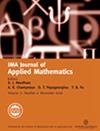An initial-boundary value problem for the general three-component nonlinear Schrödinger equations on a finite interval
IF 1.4
4区 数学
Q2 MATHEMATICS, APPLIED
引用次数: 11
Abstract
The general three-component nonlinear Schrödinger (gtc-NLS) equations are completely integrable and contain the self-focusing, defocusing and mixed cases, which are applied in many physical fields. In this paper, we would like to use the Fokas method to explore the initial-boundary value (IBV) problem for the gtc-NLS equations with a有限区间上一般三分量非线性Schrödinger方程的初边值问题
一般的三分量非线性薛定谔(gtc-NLS)方程是完全可积的,包含自聚焦、散焦和混合情况,在许多物理领域都有应用。本文利用Fokas方法,基于逆散射变换,研究了有限区间上矩阵Lax对为$4×4$的gtc-NLS方程的初边值问题。gtc-NLS方程的解可以使用在复$k$-平面上构造的$4\times 4$矩阵Riemann-Hilbert(RH)问题的解来表示。RH问题的跳跃矩阵可以分别根据与初始数据和Dirichlet–Neumann边界数据相关的三个谱函数明确地找到。还提出了不同谱函数之间的全局关系,以导出Dirichlet–Neumann边值问题的两种不同但等价的表示类型。特别地,当区间长度接近无穷大时,有限区间上的边值问题的相关公式可以在半线上生成。最后,我们还分析了Gel’fand–Levitan–Marchenko表示的可线性化边界条件。这些结果将有助于利用Deift–Zhou的非线性最速下降方法和一些数值方法进一步研究gtc-NLS系统IBV问题的解性质。
本文章由计算机程序翻译,如有差异,请以英文原文为准。
求助全文
约1分钟内获得全文
求助全文
来源期刊
CiteScore
2.30
自引率
8.30%
发文量
32
审稿时长
24 months
期刊介绍:
The IMA Journal of Applied Mathematics is a direct successor of the Journal of the Institute of Mathematics and its Applications which was started in 1965. It is an interdisciplinary journal that publishes research on mathematics arising in the physical sciences and engineering as well as suitable articles in the life sciences, social sciences, and finance. Submissions should address interesting and challenging mathematical problems arising in applications. A good balance between the development of the application(s) and the analysis is expected. Papers that either use established methods to address solved problems or that present analysis in the absence of applications will not be considered.
The journal welcomes submissions in many research areas. Examples are: continuum mechanics materials science and elasticity, including boundary layer theory, combustion, complex flows and soft matter, electrohydrodynamics and magnetohydrodynamics, geophysical flows, granular flows, interfacial and free surface flows, vortex dynamics; elasticity theory; linear and nonlinear wave propagation, nonlinear optics and photonics; inverse problems; applied dynamical systems and nonlinear systems; mathematical physics; stochastic differential equations and stochastic dynamics; network science; industrial applications.

 求助内容:
求助内容: 应助结果提醒方式:
应助结果提醒方式:


